Karumadikuttan Temple Kerala – Things to See and Do
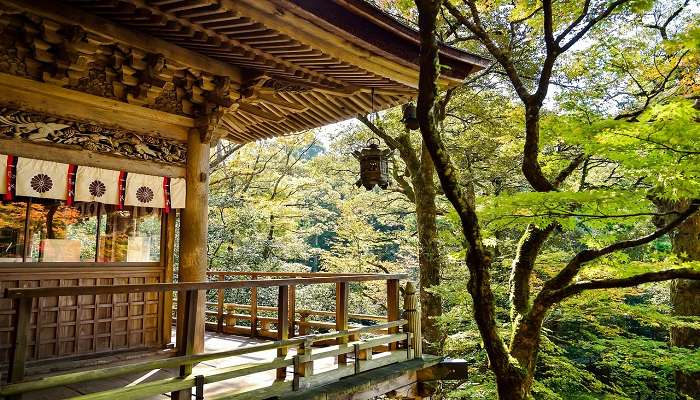
Shrouded in the verdant embrace of Kerala, the Karumadikuttan Temple stands as a solitary sentinel whispering tales of a forgotten era. The Karumadikuttan Temple houses a captivating black granite statue of Lord Buddha, a testament to the state’s rich and multifaceted past. This enigmatic site beckons history buffs, spiritual seekers, and anyone captivated by the confluence of culture and heritage. The temple’s unique character lies in its simplicity, radiating a sense of tranquillity that washes over visitors. If you want to shed the frenetic phase of your modern life, adding Karumadikuttan Temple is the perfect place to immerse yourself in serenity.
History And Mythology Of The Karumadikuttan Temple
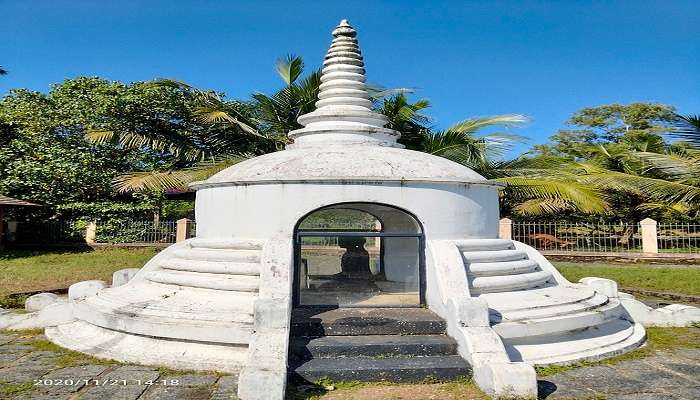
The history of the Karumadikuttan Temple is shrouded in a fascinating veil of mystery. Karumadikuttan translates to a “small boy” or a “little black boy.” The centrepiece of this temple is the captivating black granite statue of Lord Buddha, which is believed to date back to the 9th-14th centuries AD.
The Buddha idol was discovered by Robert Bristov, a leading British engineer in 1930. After finding the idol, Bristol built a temple to install the idol of Lord Buddha. Furthermore, the left side of the idol is missing since an elephant reportedly destroyed it. The temple currently resides on the banks of the Punnamada Lake and is a popular pilgrimage site for Buddhists. The temple attracts thousands of devotees from across the country and even outside India every year.
Must Read: Places To Visit In Alleppey
Best Time To Visit The Karumadikuttan Temple
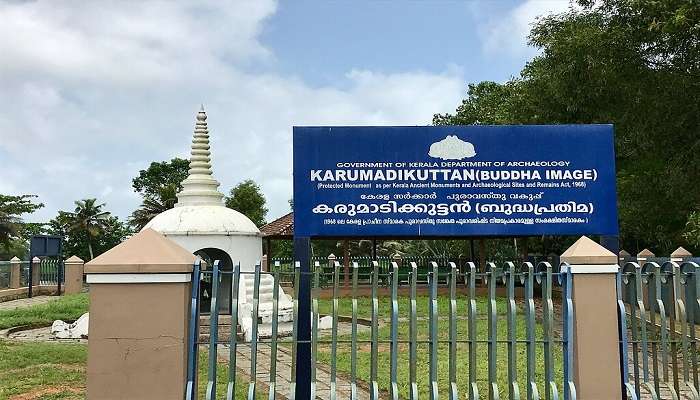
The Karumadikuttan Temple attracts visitors and devotees throughout the year. Witnessing Lord Buddha in the meditative pose is one of the most alluring sights inside the temple. The highlight of the temple is that it’s open the entire year. You can plan and visit at your convenience. However, since Kerala witnesses hot summers, visiting during the colder months from October to February is preferable.
Not only can you comfortably explore the temple, but you can also comfortably explore the surrounding sightseeing spots. Since you will ideally explore the temple barefoot, it makes sense to avoid visiting during the months with less heat.
Karumadikuttan Temple Timings
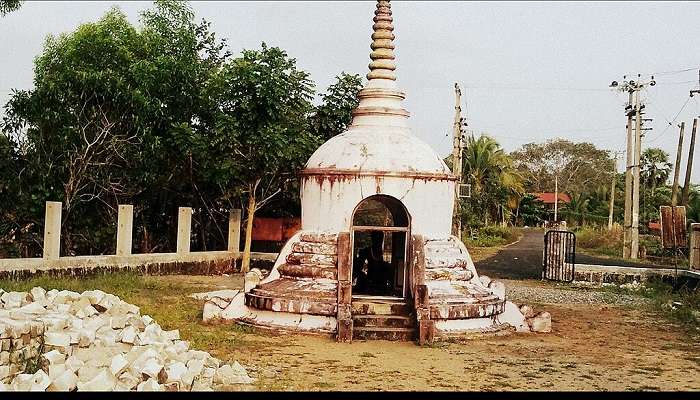
Before you step foot inside the temple to witness the Karumadikkuttan Buddha Statue in all its glory, it’s vital to be aware of the opening and closing times.
The Karumadikuttan temple opens at 09:30 AM every morning and then closes its doors for devotees at 05:30 PM. There are no queues or unnecessary rush in front of the temple. So, all that you need to do is enter the temple at your convenience, explore the surroundings and offer your prayers in the inner sanctum.
Note: The temple remains closed on Mondays. So, ensure that you plan your visit accordingly and on the days the temple is open.
Suggested Read: Kerala In Summer
Highlights Of The Temple

The primary draw of the Karumadikuttan Temple is the captivating Karumadikkuttan Buddha Statue. Take a moment to appreciate the intricate craftsmanship and the serenity it exudes. Since the temple is dedicated to Lord Buddha, you will not find the rituals usually conducted in a traditional temple.
You can offer prayers and the tranquil and calm surroundings make it ideal for meditation.
Following are a few highlights of the temple:
- The Black Granite Buddha Statue
- Learn about the Karumadikuttan history in Malayalam and the forgotten era of Buddhism in Kerala.
- Soak in the tranquil atmosphere
Places To Visit Around Karumadikuttan Temple
Beyond exploring the captivating details about the Karumadikuttan Temple’s history in Malayalam, take the time to explore the surrounding sightseeing spots. Following are a few spots you can add to your itinerary:
1. Punnamada Lake
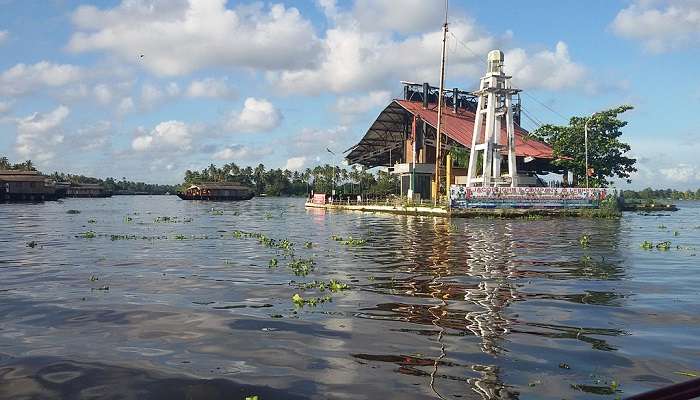
Located a short distance from the temple, the Punnamada Lake holds a lot of historical significance behind the temple’s construction and inception. Punnamade Lake is a part of the Vembanad Lake, the biggest lake in Kerala. During the Onam festival, the lake comes to life with the vibrant snake boat races. The peaceful view of the lake and the surroundings offer a delightful escape from the hustle and bustle of the city. You can opt for a boat tour or simply relax on the banks. Punnamada is the largest wetland system in India wide-spanning area of over 2033.02sq km.
Best Time to visit: August – September
Things To Do: Water sports activities, Snake boat race, Ride on the canoe, Shikara ride
Suggested Read: Munnar In October
2. Alappuzha Beach
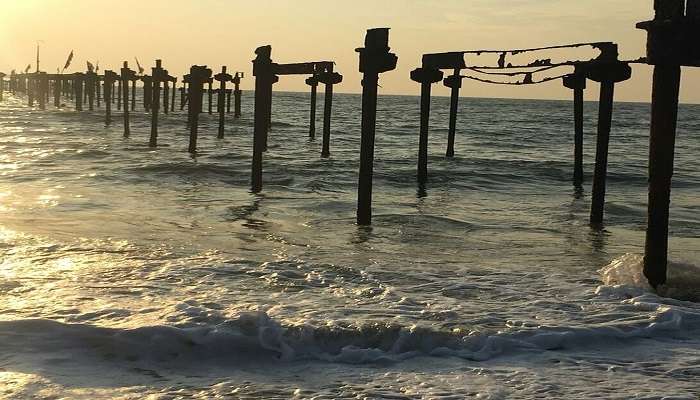
Craving a touch of sun and sand? Alappuzha Beach is fondly known as the Venice of the East. Alappuzha is the beckons for beach lovers. Pristine sands fringed with swaying palm trees and vibrant sunsets create a picture-perfect postcard. Besides relaxing under the sun, you can also stroll along the beach. Take a delightful experience while in Alappuzha on the houseboat cruise. The houseboats can be found in the backwaters of Alappuzha, they are a reworked version of the Kettuvallams of olden times. Furthermore, there are various water activities available, including kayaking, parasailing, etc.
Best Time to visit: October – February
Things To Do: surfing, swimming, parasailing, boat races
3. Krishnapuram Palace
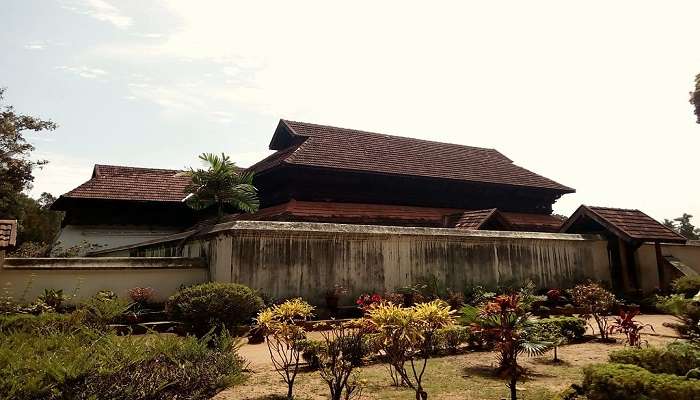
The royal allure of the Krishnapuram Palace draws visitors from across the country. Nestled amidst verdant gardens, this architectural marvel once housed the Travancore royal family. It was built in the 18th century by Anizham Thirunal Marthanda Varma of Travancore kingdom. Today, a museum showcases a treasure trove of artefacts, from exquisite murals and intricately carved woodwork to ancient weaponry and archaeological finds. It is built in Kerala’s architectural style with a gabled roof, narrow corridor, and dormer windows. It is near the Krishnaswamy Temple at Krishnapuram.
Best Time To Visit: November- February
Things To Do: Paintings, antique furniture, sculptures
Suggested Read: Temples in Munnar
4. Kuttanad Backwaters

There’s no way you can visit Kerala and not explore the backwaters. The Kuttanad Backwaters is closest to the temple, so once you finish your prayers and meditation, make your way to the backwaters. The rice granary of Kerala, spread over the districts of Alappuzha and Kottayam, and offers visitors memorable sights and experiences. You can charter a traditional houseboat, known as “Kettuvallam,” and glide through the waters. The views are immaculate and the silence and peace you experience there is beyond anyone’s comprehension.
Best Time To Visit: August -March
Things To Do: Explore canals, lakes, rivers and rivulets
5. Ambalapuzha Sree Krishna Temple
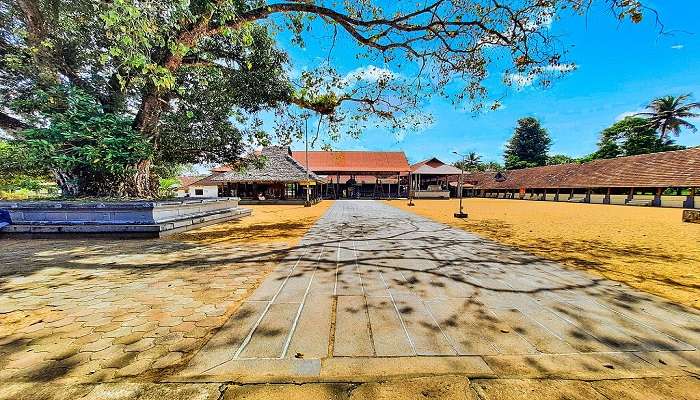
Located 2.5 km from the Karumadikuttan temple, this Hindu temple is dedicated to Lord Krishna. The temple was built during the 15th century CE by the local ruler Chembakasserry Pooradam Thirunal-Devanarayanan Thampuran. It is one of the seven greatest temples in Travancore. It is a respected Hindu pilgrimage site where the devotees visit to offer their prayers and witness the daily rituals. The temple’s highlight lies in its “payasam” offering, which is given as prasad to the devotees. Besides the temple premises, the architecture and vibrancy of the surroundings also add to the experience.
Best Time To Visit: October – March
Things To Do: Private Houseboat, Cultural Walk of Alleppey, Sightseeing
Suggested Read: Things to do on kerala trip
6. Marari Beach
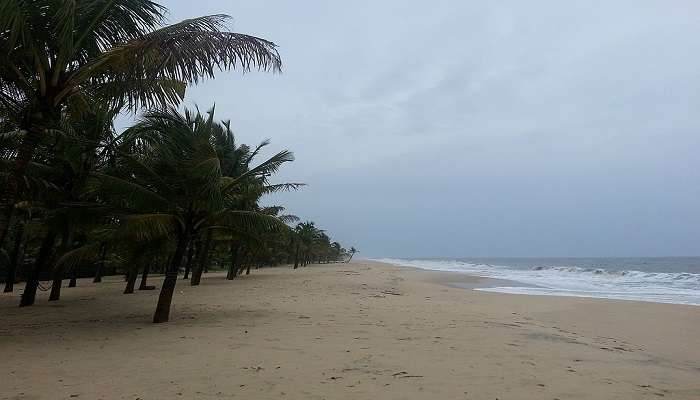
A bit of a drive away, Marari Beach is 34 km from the Karumadikuttan temple. It is a secluded, little-known beach destination in Alappuzha. It offers a serene escape from the crowds. You can choose to relax on the beach or explore the nearby fishing villages. Also, the nearby Ayurvedic resorts are great for booking a spa session. Relax and rejuvenate your mind, body, and soul.
Best Time To Visit: December – March
Things To Do: Deserted sandy beaches, sightseeing, sea surfing, parasailing, water skiing, and deep sea fishing
7. Pathiramanal Island
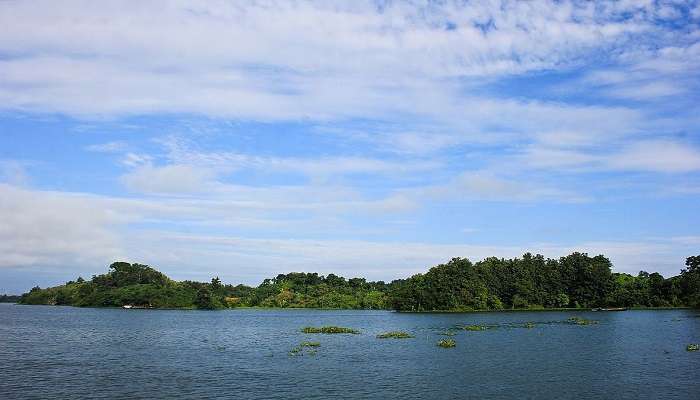
Often called the “green paradise,” Pathiramanal Island is a haven for nature lovers. It is about 1.5 km from Muhamma Boat Jetty and 13 km from Alappuzha. This small island on the backwaters is a haven for hundreds of rare migrating birds. Accessible by boat, it boasts lush mangroves, vibrant birdlife, and serene canals. Explore the island’s natural beauty on a bicycle ride, or simply relax and soak in the tranquillity amidst the verdant surroundings.
Best Time To Visit: November and March
Things To Do: Boat rides, bicycle ride
Further Read: Best places to visit in Kerala
The Karumadikuttan Temple beckons those seeking a unique cultural and historical experience. It’s a place to transcend the boundaries of religion and delve into the serenity that emanates from the ancient statue. If you have been looking to explore underrated and offbeat locations on your next trip to Kerala, this is one of those Buddhist temples that need to be part of your itinerary without any second thoughts.
For our editorial codes of conduct and copyright disclaimer, please click here.
Cover Image Source: shell_ghostcage for pixabay
Frequently Asked Questions About Karumadikuttan Temple
Is the Karumadikuttan Temple a Buddhist temple?
The temple houses the idol of Lord Buddha in his meditative pose, which explains why it is attributed to be a Buddhist temple.
Are there any festivals celebrated at the Karumadikuttan Temple?
One of the festivals celebrated with a lot of vigour in the temple is that of Buddha Purnima, which commemorates the birth of Lord Buddha.
What are the accommodation options near the Karumadikuttan Temple?
The temple is located in an offbeat location, so you will not find many accommodation options there. However, Alappuzha is nearby and houses several hotels, resorts and luxury stays.
Are there any guided tours available for the Karumadikuttan Temple?
The temple itself is in a limited area with few spots to explore. So, you will not need a guide to explore the temple’s premises.
Is photography allowed inside the temple?
There are no strict restrictions on photography inside the Karumadikuttan temple. So, you can snap pictures but be respectful of the people around you.
People Also Read:
Temples In Kerala Temples In Kochi Temples In Kottayam

With a passion for travelling, and carving beautiful stories of stunning locations I chose my profession as a content writer. The unique blend of creativity and strategy ensures that each narrative takes readers on a journey to their desired destination. With distinct locations and unique vibes, I strive to deliver captivating content that speaks to the hearts of readers.











